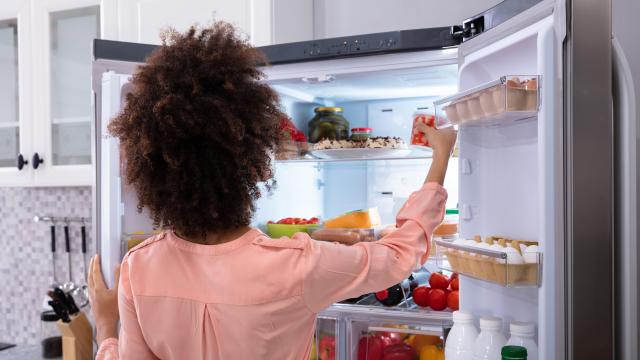It took many shameful trips to the garbage can–tossing out mouldy food and curiously sniffing heavy cream–to finally build some grown-up fridge habits. For me, a grown-up fridge is the answer to some of life’s big questions like “What’s the easiest way to stop food waste?” and “Will I ever be able to stop sniffing cream?” It’s simple: All you need to build grown-up fridge habits is a little bit of nerdy fridge organisation and an understanding of your strengths (and weaknesses).
This is part of The Grown Up Kitchen, Skillet’s series designed to answer your most basic culinary questions and fill in any gaps that may be missing in your home chef education.
Embrace FIFO
First-in-first-out is an organizational tool that helps ensure the first thing you bought, or made, gets eaten first. “FIFO” is the standard in food industry fridge organising because it works, and it’ll help your bottom line. This is ideal for items that expire quickly, things bought in duplicates, or bulk sale items. I usually buy a new almond milk, yogurt, and cottage cheese when my last one is dwindling, but not done. Instead of placing the new yogurt in front, I take the original half-eaten container out of the fridge, pop the new one in, and scoot it back. The older yogurt goes in next, so now it’s in front.
Put the small amount of work in now, so you won’t be wasting yogurt later. Sounds almost unnecessary, but maybe you know a person who just grabs the closest thing to the door even though there’s an open one behind it. This system is built for that person. Who is not you, of course.
Label your food
Condiments in the fridge door get lost in plain sight. Even if you don’t keep your jars of mustard and olives in the narrow door slot, it’s hard to FIFO them with accuracy because they’re so easy to push around and shove to the back. Before you know it, you have four opened jars of roasted red peppers, and one is definitely from your New Year’s Eve party.
Label your stored food. For jar lids, use a permanent marker and write the date you opened it right there on the lid. Use your biggest font. For reusable containers, use a piece of masking tape (fold over one end for easy removal) and write the date you made the meal, or the date you transferred the food to that container. Once you eat the food, peel off the tape, and your container is ready for the next job. No longer will you wonder if the raw ground turkey is old, and seeing the date written out will remind you that the clock is ticking.
Eat first bin (or shelf)
Even with the best organizational habits, leftovers and obscured foil-wrapped snacks get pushed to the back of the fridge, destined for a trip to the trash in a week. Battle this fate and designate an Eat First shelf, bin, or area in your fridge. This bin is great for any items that have a short life span, like some delicate veggies, items that have been FIFO-ed but are on their last legs, or small wrapped snacks that get forgotten about or shifted behind things, like the half-eaten deli sandwich you bought yesterday. The Eat First bin will prioritise where you check for food.
Now that the nerdy organisation is out of the way, the final move is to work with your strengths. Or maybe I should say, avoid your natural human weakness of forgetting what you can’t see. Out of sight, out of mind is a real thing when it comes to leftovers. When you store food in colourful containers, it’s unnervingly likely you’ll forget about them. Instead, store leftovers in clear containers (deli soup containers are a fave).
That goes for the lid too, as opaque lids can obscure the contents if the container is on the bottom shelf. When you find yourself browsing the fridge for a snack, you can see the tempting leftover roasted chicken thighs from the other night, or the last birthday cake waffle you made. It’s much more likely to get eaten promptly than discovered in the back of the fridge next month.
Building good habits can be tough, but having a grown-up fridge and reducing food waste is worth it. Start slow. Try FIFO, and once that becomes a habit, try the labelling trick. You’ll get to enjoy more food, save money, and notice an overall more organised refrigerator space.

Leave a Reply
You must be logged in to post a comment.